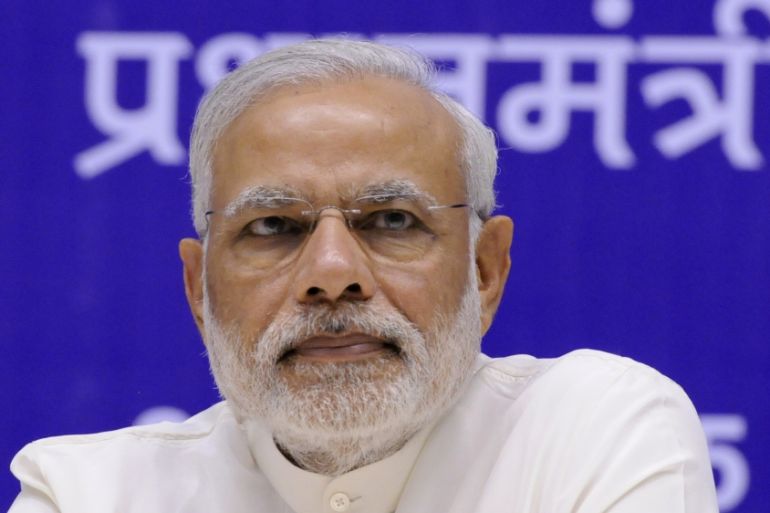Modi: India’s media magician
Nidhi Dutt looks at whether there is substance to Prime Minister Narendra Modi’s polished media operation.

It’s been a strange year for the Indian media, to say the least.
Last May, most journalists and commentators alike were full of excitement and optimism, eager to document the speed-of-light change promised by a new, “can-do” government led by Prime Minister Narendra Modi.
Keep reading
list of 4 itemsJournalist loses foot after being badly wounded in Israeli attack in Gaza
The Take: Layoffs are decimating the media industry. Who profits?
Media feel pressure to tell ‘positive’ China story as party tightens grip
Sadly, it’s been to be anything but. A social media bonanza seems to be the most fitting description of the year that was, full of self-congratulatory commentary of 140 characters or less, selfies and jingo-laden social schemes.
Some fear the fifth estate, whipped into a frenzy during the 2014 national election campaign, may now be suffering from a crisis of confidence.
The Bharatiya Janata Party’s (BJP), or more likely as word on the street has it, the media machine of the prime minister’s office, has not only driven this year’s news agenda, it’s owned it.
This year, even by the standards of the most well-versed historians, India’s political discourse and the way in which hundreds of millions of people interact with politics has changed dramatically and not necessarily for the better. Some fear the fifth estate, whipped into a frenzy during the 2014 national election campaign, may now be suffering from a crisis of confidence.
I feel like I’ve been reporting in a message vortex. Well put-together and brilliantly timed national campaign launches – from the “Swachh Bharat” cleanliness drive to the multi-billion dollar “Make In India” manufacturing push – have kept most sections of the media, the foreign press included, in a trance.
The trouble is, these media moments have been a bit like cul de sacs. The approach has been interesting but once there, we’ve driven around in circles. I should say, however, where the road has continued, the journey has been far from impressive.
Let’s take the Indian government’s “bank accounts for the poor” scheme, for example. The idea’s noble tenants made for a good news spot – free, easy-to-open bank accounts for hundreds of millions of people, a big leap forward in India’s long-term goal of giving all 1.2 billion of its citizens access to the financial system.
We covered the launch but when we went back to check on progress, there wasn’t really any. That, unfortunately, has been a recurring theme with many of the nation-building projects we have followed.
OPINION: Online Republic of Modi
Ministers and other senior civil servants have become almost impossible to access this year. The best way to find out what’s on their minds is to follow them on social media platforms.
It’s hardly surprising then that Prime Minister Narendra Modi has managed to gain 12 million Facebook followers in his first year in office. A number of those followers, I admit sheepishly, are reporters like myself who need to follow the story but can’t seem to find a way of having traditional, meaningful conversations with the powers that be.
In these new days of governance in India, the physical doors of power appear closed, guarded by paranoid government flacks and corporations with vested interests. The virtual ones, though, have been flung wide open. It’s an open secret that a lot of the ‘news’ that is generated is, in fact, part of a well-orchestrated public relations campaign.
Back in the days of the previous government, accessibility, though awfully difficult, wasn’t always completely impossible, not least for the outlets the government actually wanted to talk to. This year, the few one-on-one interviews the prime minister and a handful of approved ministers have done appear to have been the result of carefully curated, pre-filtered questions. Through them, Modi and his government have told us exactly what they want us to know. Nothing more, nothing less, and honestly, nothing we didn’t know already.
RELATED: Status, wealth, power in India’s justice system
The closed circuit of political messaging that has come to dominate the Indian news industry has made for nauseating, and in some cases, absolutely absurd reporting. Trying to report with extremely restricted access to decision-makers and little but catchy campaigns and copies of immaculately pruned official speeches to lean on, means this government’s first year in office, in news terms, is ending on a rather boring, superficial note.
We might be looking at one of the most illiberal periods for the media operating in India, with the government indulging in a form of unilateral messaging and many media outlets surrendering their irreverence in favour of adulatory reporting.
I fear social media platforms, or at least the smart tech-savy young people who create apps and emoticons of all sorts, will end up creating a “wool-over-the-eyes” function. The government may very well use it to the point where it breaks the internet. This should not, and cannot, be the future of political conversation in one of the world’s most lively democracies.